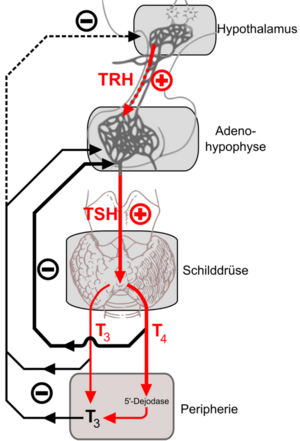Thyroid disease examination
From WikiLectures
Indicators of Thyroid Dysfunction[edit | edit source]
Serum TSH[edit | edit source]
- Its concentration is inversely proportional to the concentration of T4,
- assuming normal function of the hypothalamo-pituitary axis reflects the level of T4,
- significantly increased: primary hypothyroidism,
- sometimes a modified version is produced - it is also possible to find out
- method of first choice when primary hypothyroidism or hyperthyroidism is suspected,
- monitoring T4 replacement therapy,
- is examined in hypercholesterolemia and hyperprolactinemia.
Functional test with TRH[edit | edit source]
- Reflects TSH secretion,
- in central hypothyroidism, in TSH-producing tumors.
Total thyroxine (TT4) and free (FT4) in serum[edit | edit source]
- Indicators of current secretion,
- FT4 indicates the availability of the hormone to the tissue,
- free thyroxine index - FTI.
- Priority in the treatment of hyperthyroidism, TSH secretion can still be suppressed in the long term.
Serum total (TT3) and free (FT3) triiodothyronine[edit | edit source]
- High levels of T3 during thyroxine treatment – autonomous hyperactivity of the gland,
- indication – examination of hyperthyroidism, severity of primary hypothyroidism, differential diagnosis of low TSH values.
Reverse T3 (RT3)[edit | edit source]
- Indirect indicator of conversion of T4 to T3,
- investigation of unknown causes of low TT3 or TT4.
Serum Thyroglobulin (TG)[edit | edit source]
- Indicator of TG release from an active, inflammatory or tumor gland,
- follow-up of patients after thyroidectomy for differentiated ca as a tumor marker - diagnosis of relapse (rising TG).
α-subunit of hCG[edit | edit source]
- In general, they detect the formation of molecules with this subunit - also TSH.
Calcitonin, serum thyrocalcitonin[edit | edit source]
- Indicator of secretory activity of C-cells thyroid glands,
- in the diagnosis of medullary tumors.
Thyroid hormone transport disorders[edit | edit source]
Thyroxine binding globulin (TBG) in serum[edit | edit source]
- Quantitatively the most significant carrier,
- high values: genetically, during pregnancy, with contraception,
- low concentrations: malnutrition, malabsorption, hepatic synthesis disorders,
- we investigate T3 and T4 values, which do not correlate with the clinical condition.
Prealbumin, transthyretin in serum[edit | edit source]
- The second most important transmitter.
Binding capacity of transport proteins, T-uptake[edit | edit source]
- Meaning and indications as for TBG, we saturate the serum sample with a known concentration of T3 and determine the unbound fraction.
Indicators of autoimmune thyroid diseases[edit | edit source]
Antibodies against thyroperoxidase (Thyreoperoxidase Antibodies, TPOAb)[edit | edit source]
- Previously described as antimicrosomal,
- reveal the presence of an autoimmune process, a possible risk of dysfunction,
- indication: goiter of unknown etiology, differential diagnosis of hyperthyroidism,
- risk screening after birth.
Thyroglobulin antibodies[edit | edit source]
- They reveal the autoimmune process, can explain incorrect results of TGB determination,
- monitoring of differentiated carcinomas of the thyroid gland.
Antibodies against TSH receptors[edit | edit source]
- They can either stimulate or inhibit,
- risk of developing Graves disease, risk of endocrine ophthalmopathy,
- differential diagnosis of hyperthyroidism.
Links[edit | edit source]
Related Articles[edit | edit source]
- Thyroid
- Thyroid hormones
- Hyperthyroidism
- Hypothyroidism
- Thyroid function test
- Thyroid disease
- Radionuclide thyroid tests
- Symptomatic mental disorders in endocrinopathies
Used literature[edit | edit source]
- SCHNEIDERKA, Petr, et al. Kapitoly z klinické biochemie. 2. edition. Praha : Karolinum, 2004. ISBN 80-246-0678-X.




